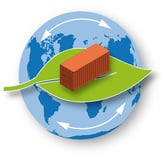How Green Returns Create Greener Supply Chains
Keith LaBotz - June 09, 2022

If green logistics make greener supply chains, why not focus on the greenest part of logistics?
That’s what companies are doing to meet the challenge of increasing economic pressures combined with growing demand for sustainability, and it’s put reverse logistics in the spotlight.
Reverse logistics is inherently green, addressing the reverse flow of products from customers for exchanges, repair, refurbishing, and recycling. Ninety-nine percent of products are trashed within six months of purchase, resulting in 2.12 billion tons of waste annually. Returns enable companies to repurpose products instead of sending goods to landfills, directly impacting a major environmental problem. And that's just for starters.
Reverse Logistics Enables Multiple Benefits
An effective returns process can enable a range of capabilities that benefit multiple areas of a business. As consumers increasingly weigh sustainability in purchasing decisions, reverse logistics can significantly improve a company’s attractiveness and bottom line.
Selling refurbished products that are as good as new eliminates manufacturing costs and associated emissions. Recycling, repairing, and remanufacturing products is also more cost-effective, and with increasing energy prices, these savings are growing.
Some of the benefits a company can expect from an effective reverse logistics process include:
- Increased profitability and sustainability.
- Minimizing extraction of raw materials.
- Reduces waste going into landfills.
- Reduces energy costs and emissions through unnecessary transportation and material handling associated with new product manufacturing.
- Minimizes supply chain carbon footprint.
- Recaptures value from existing products.
- Extends product shelf-life.
- Cost reduction through repurposing and updating finished goods.
- Reduces exposure to geopolitical risks by reducing dependency on foreign sources for raw materials, production, and transportation.
- Greater customer satisfaction from better warranty support.
- Improves future product design by incorporating customer feedback and understanding the reasons for product returns.
Reverse Logistics as a Business Strategy
While reverse logistics used to be an afterthought, now it’s a business strategy for enabling the circular economy. Sustainability also addresses everything that happens post-sale with customers and that is the focus of reverse logistics. Measuring transportation emissions and waste associated with reverse logistics is part of a product’s life cycle. With freight transport accounting for 29% of GHG emissions and record-high fuel prices, companies are paying closer attention to inbound transportation.
Focus On Transportation
Transportation is at the core of every supply chain, and reverse logistics depends on an effective transportation process. Furthermore, supply chain digitalization includes inbound and outbound transportation are entirely digitized. Reexamining reverse logistics processes is inevitable for companies that want a fully optimized supply chain.
Process improvements for reverse logistics should start with inbound transportation. To automate returns, warehouse operations need to automate receipt of incoming shipments and associated data. Carriers like UPS offer turnkey returns solutions to simplify data collection and visibility of incoming returns. This includes making it easy for customers to return packages to convenient drop-off points, including home mailboxes. Incoming shipment information is automatically forwarded to the UPS customer receiving the shipment, where enterprise business systems can record and process the product.
Corporate fleets and transportation operations can provide the same capability for customers by using a vehicle routing solution like flexis ProfiTOUR. Pickups scheduled using ProfiTOUR capture the shipment’s return authorization number for automated receipt and processing at delivery.
What Successful Returns Look Like
A successful returns process is profitable and sustainable, and easy to manage. A solution that can optimize inbound and outbound transportation during shipment planning and in daily execution is usually more effective. The more execution-level processes an inbound solution offers, the greater degree of optimization is possible.
For example, flexis ProfitTOUR automates and optimizes vehicle routing and can sequence pickups to maximize profitability and sustainability. ProfiTOUR incorporates BigMile technology to automate the measurement and reporting of emissions, making the returns process effortless.
ProfiTOUR adjusts the delivery plan enroute with changing traffic and weather conditions to minimize labor and fuel consumption.
- On-time pickup of returns.
- Reduces greenhouse gas emissions.
- Minimizes total delivery cost by economizing fuel consumption and driver time.
- Maximizes driver productivity by reducing wait times and avoiding traffic congestion.
- Visibility to incoming orders so returns receipt can be automated and material forwarded to the correct area for further processing.
CoMingling Pickups and Deliveries to Fully Optimize
An easy to manage process implies software that is capable of simplifying a high degree of complexity. Optimizing inbound transportation can be complicated, especially when it involves vehicle routing. One of the more complex scenarios is optimizing a single route for a fleet of vehicles that perform pickups and deliveries along the routeCo-mingling pickups and deliveries within a single route maximizes sustainability and profitability. The routing solution must arrange the pickup and delivery sequence to ensure sufficient space to accommodate the next scheduled pickup.
ProfiTOUR can co-mingle the pickup of returns at customer locations and deliveries of new orders. Stops are sequenced to minimize cost and emissions, avoiding unnecessary backtracking. Routes are completed with maximum efficiency, and trucks return full of incoming freight instead of empty.
Without ProfiTOUR, the freight filling the incoming trucks would have required managing separate routes, trucks, and drivers. A sophisticated routing solution like ProfiTOUR eliminates these pickups' emissions, costs, and operational complexity.
Conclusion
Focusing on the greenest part of logistics, reverse logistics, provides companies with a new business strategy for increasing profitability and sustainability. The result is a greener supply chain, and flexis products are designed to simplify reverse logistics optimization.
LATEST POSTS
- Understand Circular Economy in The Manufacturing Industry
- How Can Industry 4.0 IT Integration Be Achieved Smoothly?
- The Significance of Order Sequencing in Discrete Manufacturing
- How to improve your Supply Chain Management: The Power of Control Towers
- Optimizing Human Resource Scheduling in Manufacturing: A Technological Approach



